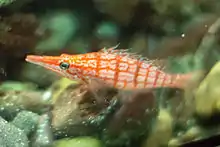| Longnose hawkfish | |
|---|---|
 | |
| Scientific classification | |
| Domain: | Eukaryota |
| Kingdom: | Animalia |
| Phylum: | Chordata |
| Class: | Actinopterygii |
| Order: | Perciformes |
| Family: | Cirrhitidae |
| Genus: | Oxycirrhites Bleeker, 1857 |
| Species: | O. typus |
| Binomial name | |
| Oxycirrhites typus Bleeker, 1857 | |
The longnose hawkfish (Oxycirrhites typus) is a species of marine ray-finned fish, a hawkfish belonging to the family Cirrhitidae. It is found on tropical reefs of the Indian Ocean and the Pacific Ocean, where it can be found at depths around 10 to 100 m (33 to 328 ft). It prefers the steep outer slopes of the reefs amongst gorgonians and black corals. This species can reach 13 cm (5.1 in) in total length. It can also be found in the aquarium trade. It is currently the only known member in its genus.[2]
Taxonomy
The longnose hawkfish was first formally described in 1857 by the Dutch ichthyologist Pieter Bleeker with the type locality given as Ambon Island in Indonesia.[3] Bleeker placed it in the monotypic genus Oxycirrhites.[4] The genus name is a compound of oxy meaning “sharp” or "pointed" and Cirrhites, an alternative spelling of the type genus of the family Cirrhitidae, Cirrhitus. The specific name typus denotes that it is the type species of its genus.[5]

Description
The longnose hawkfish differs from all the other hawkfish species in its elongated snout, the length of the snout fitting roughly twice into the overall length of the head. The canine teeth in the jaws are of uniform size and are only slightly larger than the inner band of villiform teeth.[6] The dorsal fin contains 10 spines and 13 soft rays while the anal fin has 3 spines and 7 soft rays. This fish reaches a maximum total length of 13 centimetres (5.1 in).[7] There is a tuft of cirri at the tip of each dorsal fin spine.[8] The overall colour of the body is whitish overlain with a grid of red horizaontal and vertical lines.[9]
Distribution and habitat
The longnose hawkfish has a wide Indo-Pacific distribution. In the Indian Ocean it is found from the Red Sea, along the coast of east Africa south to northern Mozambique and Madagascar across the Indian Ocean into the Pacific where it reaches as far east as the Hawaiian Islands and the Society Islands in French Polynesia north to Japan and south to Australia.[1] In Australia it occurs from south west of Barrow Island and at the Scott Reef in Western Australia, the Ashmore Reef in the Timor Sea and from Lizard Island south to Escape Reef in Queensland, as well as occurring at Christmas Island and Cocos (Keeling) Islands. In the eastern Pacific Ocean it is found from the southern tip of Baja California and the central Gulf of California south to Colombia, and at the Revillagigedos, Galapagos, Cocos and Malpelo.[10] It occurs at depths between 10 and 100 m (33 and 328 ft).[1] It is found on steep outer reef slopes which are exposed to strong currents, living among large gorgonians and black corals.[7]
Biology
The longnose hawkfish preys on small benthic or planktonic crustaceans. It is uncommon to rare in most of its range and it is a territorial species. They are pelagic spawners which form distinct monogamous pairs to breed.[7]
Utilisation
Gallery
.jpg.webp) Longnose hawkfish at Wakatobi National Park Sulawesi, 2018
Longnose hawkfish at Wakatobi National Park Sulawesi, 2018.jpg.webp) Longnose hawkfish at Siladen Bunaken National Park Sulawesi, 2017
Longnose hawkfish at Siladen Bunaken National Park Sulawesi, 2017 Close up of Longnose hawkfish
Close up of Longnose hawkfish Longnose hawkfish
Longnose hawkfish Longnose hawkfish at Galapagos Islands, Ecuador
Longnose hawkfish at Galapagos Islands, Ecuador.jpg.webp) Longnose hawkfish at Raja Ampat, Indonesia
Longnose hawkfish at Raja Ampat, Indonesia
See also
References
- 1 2 3 Greenfield, D. & Williams, I. (2017) [errata version of 2016 assessment]. "Oxycirrhites typus". IUCN Red List of Threatened Species. 2016: e.T67997854A115453267. doi:10.2305/IUCN.UK.2016-1.RLTS.T67997854A68001711.en. Retrieved 18 July 2021.
- ↑ Froese, Rainer; Pauly, Daniel (eds.) (2013). "Oxycirrhites typus" in FishBase. April 2013 version.
- ↑ Eschmeyer, William N.; Fricke, Ron & van der Laan, Richard (eds.). "Species in the genus Oxycirrhites". Catalog of Fishes. California Academy of Sciences. Retrieved 20 July 2021.
- ↑ Eschmeyer, William N.; Fricke, Ron & van der Laan, Richard (eds.). "Genera in the family Cirrhitidae". Catalog of Fishes. California Academy of Sciences. Retrieved 20 July 2021.
- ↑ Christopher Scharpf & Kenneth J. Lazara, eds. (25 February 2021). "Order CENTRARCHIFORMES: Families CENTRARCHIDAE, ELASSOMATIDAE, ENOPLOSIDAE, SINIPERCIDAE, APLODACTYLIDAE, CHEILODACTYLIDAE, CHIRONEMIDAE, CIRRHITIDAE, LATRIDAE, PERCICHTHYIDAE, DICHISTIIDAE, GIRELLIDAE, KUHLIIDAE, KYPHOSIDAE, OPLEGNATHIDAE, TERAPONTIDAE, MICROCANTHIDAE and SCORPIDIDAE". The ETYFish Project Fish Name Etymology Database. Christopher Scharpf and Kenneth J. Lazara. Retrieved 20 July 2021.
- ↑ Gaither, Michelle & Randall, John (2012). "On the validity of the cirrhitid fish genus Itycirrhitus". aqua, International Journal of Ichthyology. 18: 219–226.
- 1 2 3 Froese, Rainer; Pauly, Daniel (eds.) (2021). "Oxycirrhites typus" in FishBase. June 2021 version.
- ↑ Mark McGrouther (30 March 2021). "Longnose Hawkfish, Oxycirrhites typus Bleeker, 1857". Australian Museum. Retrieved 20 July 2021.
- ↑ "Oxycirrhites typus". Reef Life Survey. Retrieved 20 July 2021.
- ↑ "Species: Oxycirrhites typus, Longnose hawkfish". Shorefishes of the Eastern Pacific online information system. Smithsonian Tropical Research Institute. Retrieved 20 July 2021.
- ↑ "Longnose Hawkfish". Saltcorner. Bob Goemans. Retrieved 20 July 2021.
External links
- Photos of Longnose hawkfish on Sealife Collection
